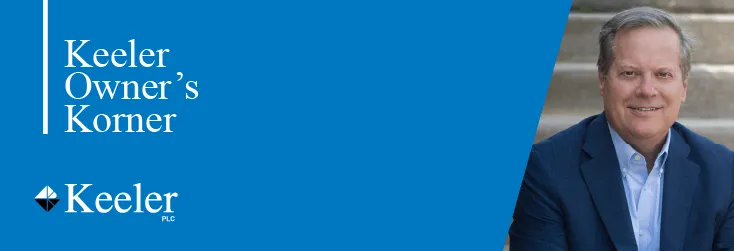

By Steven Keeler
Private business CEOs, owners and their advisers can positioned a business for near-term improvements, long-term value and eventual liquidity. Their vision, commitment and actions in doing so can make market conditions and exit timing less impactful and relevant to the company’s and its owners’ near-term and future success.
1. Company Versus Market Focus. C-Suites have to consider, but can’t control, external economic, financing and M&A market cycles. Focusing on internal company value drivers can mitigate the impact of these external factors and make them less relevant to company survival and success. What’s more, focusing on company internal value now gives ownership more options around and control over an eventual exit.
2. Plan for Tomorrow Today. A little over half of lower-middle-market businesses are owned by baby boomers and the rest by Generation X’ers. Most companies that are not position to transfer ownership to family or management will eventually sell ownership to an outside buyer. Add to that both the massive amount of corporate and PE buyout capital seeking acquisitions and the resilient popularity of private equity as an asset class and it is clear that private company sales will proliferate in the next five years regardless of fluctuating external factors. Business improvements today will enhance the bottom line, create more exit options, and ultimately ensure an exit at a fair valuation.
2. Get Your Act and Team Together Now. Value-enhancing and measurable actions started today will create near-term performance improvement and put a business on a value growth trajectory. More important, those actions will enhance company equity value and allow the owners to keep their exit options open. The best prioritized action steps should be led by a CEO or owner vision and plan and supported and executed by committed internal management and outside advisory teams. Those teams may need some changes. And the CEO and owners deserve a team leader on whom they can rely to execute the owner’s vision and coordinate all of the team players and value-driving actions.
3. Team Leader, “Quarterback” or “Coach”? You have a day job and are running a company. You are probably a star at building and running a business. As compared with more average company leaders, star leaders especially can benefit from an independent and loyal sounding board and trusted adviser in clarifying their vision, developing their action plan, and coordinating the advisory team. The company and its principal owner may have a financial or wealth planner, CPA, lawyer or other adviser who is the best team leader. Whether that team leader is a “quarterback” (having more responsibility to push the plan forward) or a “coach” (supporting the C-Suite in executing on their plan) depends on the owner’s personal talents and style and the capabilities of the team. Most private companies have good professional advisers, but many CEOs or owners have not designated one team member as a lead. You should not think of a team leader as an added cost or luxury. Your trusted team leader should be someone you like and who has deep and broad knowledge and experience in business growth and exit planning. A team leader will free the CEO or owner up from quarter-to-quarter plan execution and coordination and simply make internal management and the outside advisory team more cohesive, efficient and effective.
4. CEO, Owner and Team Commitment to “Shareholder” Value. The CEO or owner decides on the vision, plan and objectives. Team members may be focused on their respective areas of focus and expertise, but may not have the broad feel for and experience around that vision and plan and the owner’s objectives. Similar to a more internal company focus that allows a business to better navigate uncertain external factors, ownership and the teams should focus more on business equity value enhancement that merely the monthly, quarterly or annual bottom line. Actions that enhance company value should not only actually improve the bottom line but should also increase the transferable value of the business over time. It’s simple – the bottom line or “EBITDA” is important, but the business’ transferable value is what drives the ultimate transaction “multiple” that “multiplies” that EBITDA into a good valuation or equity purchase price. And, ultimately, owner take-home value will depend on other moving parts, including the company’s capital structure, the owners’ personal financial goals, the deal consideration and payment terms and, regrettably, taxes. Addressing these now will further enhance company and owner flexibility and optionality.
5. You’ve Run a Good Race, So You Deserve to End Well. Many great private companies fail to achieve a strong exit because of the distractions of day-to-day blocking and tackling, some tunnel vision toward income versus business value enhancement, and fears about constantly changing and less controllable external factors. It’s the CEO or owner’s choice. Developing a vision, objectives and action plan today, and leveraging company management and the company’s and owner’s advisory team toward executing on the vision and plan, with the help of a team leader whose job is to support the CEO or owners and serve as a traffic cop, should transform otherwise frustrating planning and uncertainty into real actions that drive business value and, it follows, the bottom line and ultimate exit value. Putting value-enhancement or “exit” planning off until some unexpected event or a decision to sell the business may often reduce company and owner flexibility and options and their sale price. Put another way, making exit planning part of business financial and strategic planning will improve performance and value today and afford the opportunity for exponential growth in the coming months or years.

© Copyright 2021 by Keeler PLC
All rights reserved.
Terms of Use & Privacy Policy
Design by NexFirm